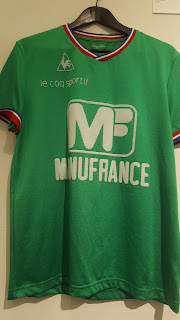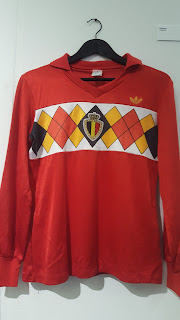Curator Neal Heard, a football historian and fanatic, considers the humble football jersey "a unifying item" and, if you ignore the significant minority of people who go round punching each other in the face for wearing the wrong one, he's got a point. If you meet a stranger in a pub, something I do less often these days, quite often football will be one of the first subjects to come up. It certainly gets people quite passionate. Even those who boast (often very loudly) of hating football do it with an almost breathtaking passion.
The Brick Lane show takes in a mixed bag of shirts. From the classic club and country designs to the infamous, ill-advised, and just plain weird. They've also sought to have a look at where the world of football collides with the worlds of music, fashion, and politics. As you enter you're greeted with what is essentially the first XI. England '66, Celtic, Argentina, you can guess the rest. You can see the rest.
Catching my eye immediately was the section devoted to music and football. I've always been more a fan of music than football but when I grew up it was quite rare for the two to meet. Italia '90 and New Order's World In Motion, along with the likes of Colourbox and the fanzine When Saturday Comes, went a long way to changing that and now they're regular bedfellows, Oasis sporting Manchester City 'Brother' shirts in their early days, Super Furry Animals loud support for Cardiff City, Goldie Lookin' Chain sponsoring Newport City, and Skint Records logo emblazoned on the shirts of Brighton and Hove Albion. Kasabian even linked up with the England national team to launch a new kit.
Rod Stewart's passion for the Scotland team predated that, as did Elton John's chairmanship of Watford, and in the lae 70s Bob Marley wore the above Nantes shirt. Half Man Half Biscuit have done more than anyone to combine football, music, and humour. Most famously with their song All I Want For Christmas Is a Dukla Prague Away Kit. Anyone fortunate enough to attend an HMHB gig is likely to witness plenty of these sartorially pleasing items but you'll be in less luck if visiting Prague. Dukla, winner of 11 Czechoslovak league titles, dissolved in 1996, eventually becoming FK Pribram.
The WBA top of '77-'78, famously worn by The Three Degrees (as Ron Atkinson, in far from his worst outburst on race, dubbed Laurie Cunningham, Cyrille Regis, and Brendan Batson), was also worn by the actual Three Degrees (Helen Scott, Valerie Holiday, and Sheila Ferguson) when they visited The Hawthorns. I like to imagine the sweet sound of Philly soul temporarily replacing Liquidator as Bryan Robson and the boys ran out to the cheers of the Brummie Road end.
Not quite sure if the Hull City fans of '94 would've been quite so impressed with this tiger print number but I'm sure once Dean Windass had knocked a few in they got used to it. It's part of a section of the show called From the Street to the Catwalk which looks at fashion dos and don't amongst the soccer tops. PSG's 1970s kit was the work of French designer Daniel Hechter and, these days, labels like You Must Create get involved in shirt design.
Nigeria's '94 shirt (as worn by such luminaries as Finidi George, Jay-Jay Okocha, and, er, Efan Ekoku) is one of many that appropriates the culture of the country, or city, it represents. It could, from a distance (if you squint), look like part of a traditional Nigerian outfit.
The same could easily be said for Jean-Paul Gaultier's France away kit from 2011. You'd half expect the team to cycle in to the Stade de France with strings of onions round their necks and bags of baguettes in their panniers. It is gorgeous though and as a big fan of stripes I'd happily wear it.
Couldn't say the same for Arsenal's early nineties eyesore. You start to wonder if it was more the opposition's aversion to the glare of the shirt than the defensive capabilities of Tony Adams, Lee Dixon, Nigel Winterburn, and Steve Bould that gave the Gunners one of the most impressively low numbers in the GA column.
Liverpool's iconic Candy shirt takes you back to the last time they were, truly, the dominant force in English football. Fans of my generation can probably cast their minds back to a time when John Barnes, Peter Beardsley, Gary Gillespie, Alan Hansen, and Steve McMahon dominated all around them. As a shirt design it's no classic but as a piece of cultural history it serves the exhibition well.
The opposite is the case for Fiorentina and Huddersfield Town's garish 1991 shirts. Steve Hardwick and Stefano Borgonovo were, whether they liked it or not, embracing the baggy scene's penchant for loud clothing. They probably ran on to The Bridewell Taxis.
The German away kit of '94-'95 is infinitely preferable though it's unlikely it did much to rehabilitate the likes of Lothar Matthaus, Rudi Voller, and Andreas Brehme in the eyes of the English supporter.
The 1994 World Cup was the first that Germany competed in as a reunified nation (they famously lost in the quarter finals to the Hristo Stoichkov inspired Bulgarians) so it neatly led us from fashion to politics. Politics and football have always been uneasy bedfellows (Robbie Fowler's support for the dockers, Margaret Thatcher's undisguised contempt for the game and its fans, Kevin Keegan once claiming he'd like to be PM before playing headers and volleys with Tony Blair) and so this short section shows.
Hummel controversially designed a shirt for the Tibetan national team despite FIFA refusing to recognise their international status (presumably so as not to upset the powerful Chinese) but that's as nothing compared to Fiorentina's '92-'93 shirt (above) which had to be withdrawn after people noticed the pattern included a swastika. Something that supporters of Hamburg's 'punk rock anarchic' club St Pauli (shirt from '89-'90, second below) would no doubt have frowned upon very heavily.
In 1982 Stockport County's away kit was withdrawn mid season. Having a shirt so very similar to the Argentine national team was not considered good form at the height of the Falklands War.
Legendary Brazilian midfield maestro Socrates led his Sao Paulo based Corinthians team mates in a push for players rights and democracy with the above t-shirt looking affair and Medureira S.C. went as far as commemorating the fiftieth anniversary of their team's meeting with the revolutionary Che Guevara in their shirt design.
What Guevara did for revolutionary politics some would say Eric Cantona did for Manchester Utd. In 1993 when Cantona (along with Steve Bruce, Ryan Giggs, and Brian McClair) finally broke Man U's hoodoo and they won the league for the first time in 26 years their away kit was a fairly forgettable speckled blue affair but when they repeated the feat a year later the more intimidating black shirt had replaced it. It's the one Cantona was wearing when he jumped into the stands at Selhurst Park to kick Crystal Palace fan Matthew Simmons in 1995. You can tell it's Cantona's (as opposed to that of Lee Sharpe, Mark Hughes, or Andrei Kanchelskis) because of the trademark upturned collar.
Arsenal's celebration of two decades partnering with Nike may be an indicator of the corporate greed that's ripping the soul out of the beautiful game but it's a nice colour. More unusual sponsors crop up on the shirts of Boca Junior (sponsored by Fiat in 1991) and the '89-'90 Napoli shirt. Diego Maradona and Gianfranco Zola's nipples must've been bleeding by half-time in this aesthetically pleasing, if rather heavy looking, classic. It seems unlikely, also, that Maradona's stimulant of choice was a Mars bar. He found other ways to work, rest, and play.
In 1976 St Etienne lost the European cup final 1-0 in Glasgow to a solitary Franz Roth goal for Bayern Munich. Nevertheless they won the optics and I wonder if the above sartorial delight helped one of the UK's most under rated bands choose their name.
It'd take a real spotter to recognise that one straight off the bat but no football fan worth their salt would fail to spot a Barcelona shirt from any era. The red and blue stripes are up there with the orange of Holland and the yellow of Brazil amongst the most famous shirts of all times. They must sometimes feel like they're worth a one goal headstart.
Whilst Barca's links to Catalan nationalism and independence have always led to an uneasy, if not non-existent, relationship with sponsors very few other clubs have an issue with that these days. Eintracht Braunschweig, now plying their trade in the second tier of the Bundesliga, were the first German team to take up shirt sponsorship with, of all things, Jagermeister emblazoned across their chests. The stuff makes me puke not want to play football.
Belgium's mid-eighties top, despite looking like something a sports harlequin might wear, is actually quite pleasant though it didn't stop them getting spanked 5-0 by a Platini inspired France at Euro 84 in Lyon. Ten years later shirts, in Japan at least, had mutated into the Nagoya Grampus Eight monstrosity below.
It's a long way from Brazil's gold. The shirt above was their World Cup '78 effort (the team of Zico and Rivelino finished third in a tournament won by their neighbours and rivals Argentina at home in Buenos Aires). Along with the almost rugby looking Newcastle Utd '95'-'96 (wouldn't you have just loved it, looooved it if the team of Ginola, Rob Lee, Beardsley, and Philippe Albert had held on to win the title that year?), Italy's 1986 goalkeeping jersey (sadly worn by Walter Zenga, Franco Tancredi, and Giovanni Galli - but not Dino Zoff, who played his last game for Italy in '83), and Holland's '80 classic (the team of Frans Thijssen and Johnny Rep) it makes for a great finale to a fun, free, fascinating, and let's face it, frivolous little exhibition.
Thanks to Owen Guthrie-Jones for giving me the heads up on this (and for the nipple joke). It really was an education.



































No comments:
Post a Comment